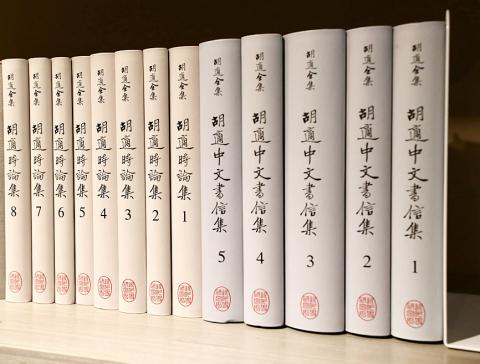Academia Sinica yesterday published The Complete Works of Hu Shih (胡適全集) to mark the writer’s 127th birthday, featuring rare pieces on freedom, democracy and communism unseen in the Hu Shih oeuvre published in China in 2003.
Hu is the most important Chinese intellectual of the 20th century and his writings are highly valuable, said Pan Kuang-che (潘光哲), the head of Academia Sinica’s Hu Shih Memorial Hall.
Hu has written extensively on freedom, democracy and criticized communism in the late 1940s and in the 1950s, when cross-strait relations were most tense, but none of the writings were included in his complete works published in China in 2003, he said.

Photo: CNA
They have been finally published after Academia Sinica’s Institute of Modern History spent six years collecting Hu’s works for the new compilation, he said.
For example, Hu wrote a letter to a friend in 1939, when Mao Zedong (毛澤東) first took over Beijing, saying freedom would definitely not be permitted under the Chinese Communist Party, Pan said.
His friend tried to convince Hu to switch allegiance, but he responded that he no longer had the freedom to remain silent, Pan said, adding: “How could such a letter be published in China?”
According to Hu, fighting communism was necessary to safeguard freedom and democracy, Pan said.
Early intellectuals like Hu offer examples of how people can resist communism today as readers reflect on their ideas and consider ways to further improve them, he said.
In China, people do not even have the freedom to study Hu, as he has written about the conflict between democracy and authoritarianism, Pan said.
China’s censorship is unrelated to Marxism, he said.
“So many books have been banned and censored and churches are being closed down,” he said, adding that the new Complete Works of Hu Shih would likely be banned in China as well.

An essay competition jointly organized by a local writing society and a publisher affiliated with the Chinese Communist Party (CCP) might have contravened the Act Governing Relations Between the People of the Taiwan Area and the Mainland Area (臺灣地區與大陸地區人民關係條例), the Mainland Affairs Council (MAC) said on Thursday. “In this case, the partner organization is clearly an agency under the CCP’s Fujian Provincial Committee,” MAC Deputy Minister and spokesperson Liang Wen-chieh (梁文傑) said at a news briefing in Taipei. “It also involves bringing Taiwanese students to China with all-expenses-paid arrangements to attend award ceremonies and camps,” Liang said. Those two “characteristics” are typically sufficient

A magnitude 5.9 earthquake that struck about 33km off the coast of Hualien City was the "main shock" in a series of quakes in the area, with aftershocks expected over the next three days, the Central Weather Administration (CWA) said yesterday. Prior to the magnitude 5.9 quake shaking most of Taiwan at 6:53pm yesterday, six other earthquakes stronger than a magnitude of 4, starting with a magnitude 5.5 quake at 6:09pm, occurred in the area. CWA Seismological Center Director Wu Chien-fu (吳健富) confirmed that the quakes were all part of the same series and that the magnitude 5.5 temblor was

The Central Weather Administration has issued a heat alert for southeastern Taiwan, warning of temperatures as high as 36°C today, while alerting some coastal areas of strong winds later in the day. Kaohsiung’s Neimen District (內門) and Pingtung County’s Neipu Township (內埔) are under an orange heat alert, which warns of temperatures as high as 36°C for three consecutive days, the CWA said, citing southwest winds. The heat would also extend to Tainan’s Nansi (楠西) and Yujing (玉井) districts, as well as Pingtung’s Gaoshu (高樹), Yanpu (鹽埔) and Majia (瑪家) townships, it said, forecasting highs of up to 36°C in those areas

The brilliant blue waters, thick foliage and bucolic atmosphere on this seemingly idyllic archipelago deep in the Pacific Ocean belie the key role it now plays in a titanic geopolitical struggle. Palau is again on the front line as China, and the US and its allies prepare their forces in an intensifying contest for control over the Asia-Pacific region. The democratic nation of just 17,000 people hosts US-controlled airstrips and soon-to-be-completed radar installations that the US military describes as “critical” to monitoring vast swathes of water and airspace. It is also a key piece of the second island chain, a string of